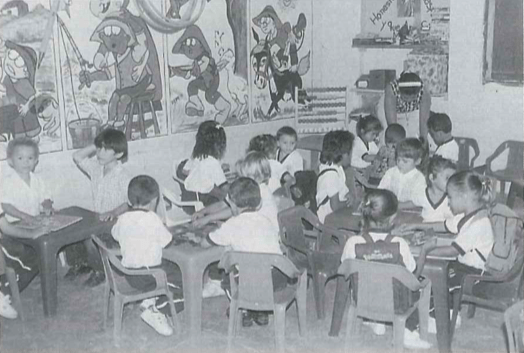Colombia: Teacher and School Incentives
Promoting participation to improve school quality

A scrapbook compiled by teachers and parents show children happily learning.
You can bring the horse to water, but you can’t make him drink,” goes the old saying. Education planners and reformers often find the adage all too true when they try to implement plans without engaging teachers or creating incentives for their participation. Even well-formulated and funded reform initiatives are sometimes frustrated by the failure of their supposed implementers — teachers, students, administrators, parents and communities— to change or adopt new behaviors.
In many Latin American countries, factors such as the antagonism of teacher unions, scarcity of resources or low technical capacity of individuals and institutions are frequently blamed for lack of effective implementation. I do not doubt these problems are critical barriers that need to be overcome. However, my experience in Colombia leading the Ministry of Education’s Teacher and School Incentives’ Program, showed me that when educators and communities know and understand what the reform calls for, find an individual and collective meaning and sense of mission in its purposes, haveincentives to engage in it, and can do what the reform calls for with their personal know-how, the dynamics and energy to get the reform going are a given. Although this may sound commonsensical, these are factors that are frequently ignored or taken for granted by reformers.
The Context for the Teacher and School Incentives’ Program
Colombia’s 1994, education reform act (Ley 115) set a new legislative base to address the multiple challenges faced by the education sector in terms of access, quality, and equity. Decentralization and new spaces for participation gave teachers, administrators and communities new roles and a greater responsibility in addressing local educational needs. However, as is many times the case, more is said than done. In early 1995 very little had changed at the local or school level and it became evident that teachers in many classrooms remained uninformed of the reform’s goals and processes. Moreover, the resources allocated for the reform were put at risk by a new salary increase demand and threats of strike from the teachers’ union.
After a long and difficult negotiation with the union, the Ministry of Education created an Incentives Fund for rewarding those schools and teachers making efforts to improve their schools and implement the reform.
The Teacher and School’s Incentive Program
The incentives strategy called for a massive evaluation of schools and teachers. During 1995’s second semester, the Ministry of Education developed indicators of “school quality” and of “reform advances” to evaluate schools and teachers and to “translate” the objectives of the reform into clear and attainable goals. The program designers also collected children’s opinions of what they think is a good teacher to use as criteria for the evaluation (See Box1). The following decisions for the implementation of the program were made:
- All 40,000 primary schools in the country were eligible to participate voluntarily.
- Based on the standards prepared by the Ministry, each participating school would elect their “best” teacher to receive an economic incentive. Preference would be given to teachers who worked in the first three grades.
- One school out of every school cluster in the country would be selected to receive an economic incentive to invest in school improvements. Colombia has approximately 2000 school clusters, each of which is directed by a cluster director who is the link between schools and municipal authorities. Each cluster has from 15 to 30 schools, both urban and rural.
- Regional authorities and cluster directors would implement the program.
- Cluster directors and supervisors would inform teachers, principals, parents and students of the process and objectives of the program and motivate them to participate in the evaluation.
- In an open meeting, teachers, students, parents and the school council would discuss and examine their school and teachers’ performance under the evaluation criteria provided by the Ministry.
- Cluster directors would check for evidence on what was stated on the evaluation forms to select the best school in the cluster.
The evaluation process was accompanied by a massive communication strategy that stated the program’s philosophy and gave meaning to the purpose of the reform. The following are some of the messages that teachers and schools received through radio, television, and newspapers:
“All professions have a project for social equity and justice. We contribute to equity when all our students learn-this is our ethical responsibility-in particular if we are teaching the children of the poor. Knowledge is the currency of the future, we educators are the bankers of this currency!”
“A school is good when all students learn what they have to learn, in the moment they have to learn it, and do so in harmony and happiness. We educators must understand and help parents and society understand, that if we join our efforts and offer students the opportunities they need, all are capable of learning.”
“A good professional does not blame her students for failure. Strangely, education is planned, administered, paid, and carried out by adults?But? when something fails it is the student who is blamed! Every failure of a student is a professional failure of his teacher!”

A scrapbook compiled by teachers and parents show eager children.
A Participant’s Experience
One school supervisor and regional coordinator for the Teacher and School Incentives program in the Department of Putumayo, describes her reasons to be optimistic and hopeful. The supervisor, whom we’ll call Carmen RodrÃguez, since she requested her name not be used, is one of the 2,000 school supervisors and cluster directors who visited each of the country’s 40,000 primary schools in the context of the National Teacher and School Incentives Program to select and reward the best schools and leave guidelines to improve the rest.
During her strenuous and long journey through the mountains and rain forest of southern Colombia where she visited schools and met with communities, RodrÃguez witnessed the enthusiastic response of teachers, students and parents to the Ministry of Education’s call to evaluate and improve the quality their schools. Even though this visit gave RodrÃguez a painful first hand view of the dismal situation of schools in this coca-leaf-growing region struck by drug and guerrilla wars, she was impressed to see how communities mobilized and worked hard to improve their schools. In a letter to the Ministry of Education, RodrÃguez gave testimony of her experience: “?Can you imagine how very happy the communities felt?! They said that government had given them the opportunity to evaluate their teachers and schools and were well prepared for the day of the evaluation. Some had whitened the walls of their school to a sparkling new freshness after raising funds in the community, others had organized collective work days to clean the schools and plant gardens and trees; others began to organize the school vegetable garden?everyone had made a big effort to be the best the day of the evaluation.”
Experiences like that of Carmen Rodríguez, that in one way or another engaged communities in school improvement efforts were replicated in many of the country’s 40,000 primary schools. Although there are no silver bullets for improving schools– and Colombia’s program does not pretend to be one– change in education is unlikely to happen without the active participation of those who make part or have stakes in the educational process. Colombia is an example that this can be done.
Spring 1999
Claudia Uribe is a doctoral student at the Harvard Graduate School of Education in the area of Administration, Planning and Social Policy. Before coming to Harvard she was Director General of School Organization in the Ministry of Education in Colombia, where she was responsible, among other things, for the design and implementation of the Teacher and School Incentives Program.
Related Articles
Editor’s Notes: Booknotes
On March 10, 1999, President Clinton apologized to the people of Guatemala for the support provided by the U.S. government to that country’s repressive military-backed governments…
Society and Education
As a member of UNESCO’s International Commission on Education for the Twenty-First Century, I’ve come to realize that education is about much more than books. It’s about the “four pillars of…
Noel McGinn’s Life of Learning
Noel McGinn, professor of education, had a normal American childhood in a small, sleepy town directly south of Miami-but 1200 miles south and across the Caribbean, in the Panama Canal Zone…




